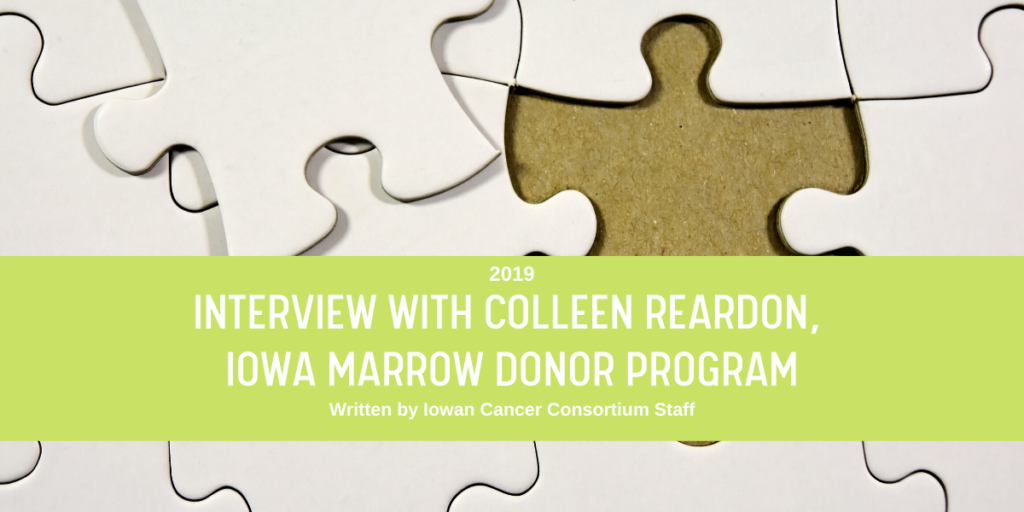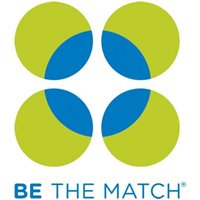Interview with Colleen Reardon, Iowa Marrow Donor Program


Tell me a little bit about your organization (Iowa Marrow Donor Program) and Be The Match.
I work for the Iowa Marrow Donor Program. We actually pre-date Be The Match here at the University of Iowa Hospitals. We did our first unrelated transplant in 1981 and Be The Match started in 1987. We started with platelet donors through the DeGowin Blood Center, consenting them to be willing volunteer donors for patients in need and we have continued that ever since. When the National Marrow Donor Program started in 1987 (now Be the Match), we joined them because our mission is the same – to save lives through cellular therapy.
We are trusted leaders in this field, and we never lose sight of our purpose which is to deliver cures for blood cancer. From the point of when the patient is diagnosed, we are there every step of the way to help them through this process. We help all families by traveling throughout Iowa and encouraging young, healthy adults to consider donating, and then register as a blood stem cell donor.
How long have you been with this organization?
I started with this organization 34 years ago. It has been inspiring for me from the day I started until today. I am still inspired by the patients we strive to help.
Most rewarding part about your job? The most challenging?
The most rewarding is to be with donors and their loved ones when they donate. We recruit and have many young adults come in to donate. Many active college students come in and donate, and they typically come in with their parents. To see the look of admiration on the parents face when they see their adult child make this decision to help save the life of someone they don’t know. It is just incredibly rewarding.
The hardest part for me is not being able to find matches for everybody. It is so hard because we know out there somewhere, there may be a match, but we just haven’t gotten to them yet. They just don’t know about us and we really, really need people even if they are not young adults. We need everyone to share this message because you just never know who is going to hear it and who will say “I didn’t know about that. I would be willing to save somebody’s life.”
Can you tell me the process of extraction for bone marrow?
There are two ways people are asked to donate:
Bone Marrow
(typically when a donor matches a child)
- A patient will arrive early in the morning to the surgical center. They will meet with the anesthesiologist and choose between general anesthesia or an epidural. They will then be taken back to the operating room, where they will donate their bone marrow. The marrow is taken out of the back hip bone, called the lower iliac crest, using a needle. There are no stiches, we just use a needle on both the left and right side.
- One of the main reasons donors receive anesthesia is because there are nerve endings in the bone marrow cavity. Once we start to take a little bit of bone marrow, it changes the equilibrium in that bone marrow cavity, and the nerves can start to fire. We want to keep the patient as comfortable as possible.
- The whole process lasts less than two hours. It is pretty quick. The amount that we take out is less than 10 percent of what the donor has in their body. This way, their immune systems functions just the same. Just like when a blood donor donates blood, and they make more blood, a marrow donor when they donate, their body replaces that. Their body creates new marrow.
- The donor typically leaves the hospital in the early afternoon to travel back home. After the donation, the donors usually tell us that their backs are stiff and sore for about a week or two. If needed, we give them some medication to help with that, but most donors do fine on their own.
Blood Stem Cell
(typically when a donor matches an adult)
- The process for donating It looks a lot like donating platelets. The difference is we (our bodies) don’t have enough stem cells to give away. Our donors are going to receive an injection of a drug once a day for five days, which makes our bodies produce more stem cells in our bone marrow where it will then push more into our bloodstream. We hire a home health nurse to go to the donors home or dorm room, or college apartment, wherever the person is living to administer the drug for 5 days.
- On the fifth day, they come in to the University of Iowa Hospitals and Clinics in the morning to donate at the DeGowin Blood Center. They sit in a nice, comfy chair with a warm blanket with their family members/best friend to sit right with them. Typically they watch a movie or listen to music. It lasts 2-3 hours, and after the donation they go home.
Note: Both are outpatient medical procedures done in a hospital. When they come, they come with a family member or friend. We cover the travel expense and meals for the donor and whoever comes with them.
There is quite a stigma with donating bone marrow. Can you expand on what these stigma’s are?
One myth is that it hurts. When you donate marrow, it doesn’t hurt. After the procedure, your back is going to be stiff and sore for a little bit of time, but most people are back to their normal activities in a day or two after donating. It is a medical procedure, and what we want people to think about is are you willing to have a sore and stiff back for a few days in exchange for giving the patient and their family a chance of a lifetime.
The second myth is it takes too much time. I can’t do it, I’m a busy professional or college student. To be a marrow or stem cell donor, two days will be taken away from normal activities. One day is when they are first identified as a potential donor. We need to have them come see us and have a physical exam to be sure they are healthy. They have to pass a physical in order to donate. Not everyone who joins the registry and matches a patient is allowed to donate. Sometimes we find things during the physical exam that the donor didn’t know they had, and they are unable to donate. A few weeks later, they are going to give us another day when they donate. That is all the time involved for donation.
The third myth is it is expensive and costs money to donate. We have a very supportive program so there are no medical expenses to donate, but also there are no other expenses. Travel is covered for all of it. When the individual drives down for the physical, and then in a couple weeks to donate, we reimburse them for their mileage, food, hotel, kennel if they have a dog, and pay for the sitter if the donor has children. If the donor is a college student, and they want their mom to be with them and they are from California. We will fly the mom out to be with their son or daughter when they donate. It is a super supportive program because we honor, respect, and celebrate our donors. We want the experience of donating to be something special for them.
How do you fund all of expenses such as the medical procedure, and flying someone out?
We fundraise to help us here in Iowa to educate, recruit and bring people into the registry and also nationally to cover the expenses. There are two organizations that fundraise: Be The Match fundraises for what they cover and of course the Iowa Marrow Donor Program for what we cover.
What are some ways an individual can volunteer with this organization?
- Volunteer their time by helping us at events. Help set up tables, educate and encourage people to register online. All registration is done online.
- Spread the word about our program through social media. We can provide links and image content. Sharing the links will help get the word out about donations.
- Fundraising and coming to the fundraising events. Most of the fundraising has been through our campus groups.
- Liking us on Facebook: The Iowa Marrow Donor Program.
Are there some other important things you would like to share about the registry?
Our registry does not reflect the diversity of individuals living in United States. It is highly Caucasian-based, so patients who are ethnically diverse have a much smaller chance at finding that match on the registry. Here at the Iowa Marrow Donor Program, we are committed to giving each patient the best chance to survive. We are reaching out into ethnically diverse communities and educating people, and really encouraging them to open their heart and think about helping others. Ethnically diverse populations are grossly under represented on the registry.
People need to understand that patients and the families that find themselves in this position, they just want a chance. They just want their loved one to get that chance. What the donor gives that family is the peace of knowing that they got to try everything. That donor is the key. Without the donor, the team can’t work. We need a healthy, willing, person that wants to be a part of a life saving team.
Not everyone who registered is called to donate. 1 out of every 430 people who registered are matched to a patient and are asked to donate. For the vast majority of people, they never donate. They are never matched to a patient. A person registers knowing that they may never be called, but if you do, you need to be willing to be that donor. We don’t want people who haven’t thought the process through. It has happened where there will be one donor listed in the whole world for the patient, and when that donor is contacted they don’t want to do it. We understand that people’s health can change from the time they signed up, till now.
What does the registry look for specifically for a match?
Antigens that make up the immune system. It changes over time. When I first started we looked for 6/6 and it was a perfect match. Now we have a 12/12. We are constantly improving. When I first started, the survival rate from a transplant was 30%, and now it is 70%. We continue to get better and better, and continue to learn matching, and we continue to develop pharmaceuticals that help in transplant. It is an evolving field.
